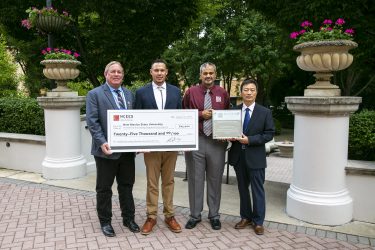

Date: 07/19/2019
Writer: Linda Fresques, 575-646-7416, lfresque@nmsu.edu
The National Council of Examiners for Engineering and Surveying recently awarded the New Mexico State University Geomatics/Surveying Engineering program the grand prize for the 2019 NCEES Surveying Education Award. This annual award recognizes surveying programs that best reflect the organization’s mission to advance licensure for surveyors in order to safeguard the health, safety and welfare of the public.
 (Left to Right) NMSU Geomatics Instructors Kery Greiner and David Acosta, along with Associate Professor Ahmed Elakser and Department Head Ruinian Jiang accepted the NCEES Surveying Education Grand Prize this August. |
The honor brings a $25,000 grand prize to support the NMSU program’s continued efforts to promote the importance and value of surveying licensure. The award jury considered criteria such as student outcomes and involvement; outreach and recruitment; and the promotion of licensure. Surveying Engineering and Geomatics Associate Professor Ahmed Elaksher and Engineering Technology and Surveying Engineering Department Head Ruinian Jiang traved to Washington, D.C., in August to accept the award.
NCEES Surveying Education Award juror Henry Dingle said, “The jury was very impressed with the constant advancement of the geomatics/surveying engineering program over the last four years. It could be a model for other programs across the country.”
“This national recognition is particularly meaningful because NMSU recently redesigned the curriculum for its surveying and geomatics program,” said College of Engineering Dean Lakshmi N. Reddi. “The geomatics program was developed with substantial direction and support from industry, state and national professional societies. This recognition validates that our efforts were made in the right direction.”
The geomatics four-year bachelor’s degree features updated coursework that includes instruction on emerging technologies to define the world in which we live, such as drones, satellites and laser scanners. Students learn how to apply integrated mathematical and computational approaches to visualize and analyze geospatial data. They also learn the legal principles of boundary location, land development techniques and the geometric properties of the Earth. Graduates serve the needs of our community by safeguarding life, health and property and promoting the public welfare.
It also offers flexibility in degree completion. Students may begin the program while attending community college or online and complete the last two years of technical coursework remotely or at NMSU’s campus in Las Cruces. The program has established several cooperative agreements with community colleges nationwide with more in the works. Plans call for the program to be fully available online in the near future.
NMSU has the only four-year degree program in geomatics in New Mexico. The new program is seeking accreditation by the Engineering Accreditation Commission of ABET. Since the introduction of the revamped program, enrollment has nearly doubled and is continuing to grow.
“Our surveying engineering graduates have 100 percent employment and earn very competitive salaries,” said Reddi. “This is a field that is in high demand. With more surveyors retiring nationwide and the advances in this field, the demand for well-educated and skilled surveyors is booming.”
Graduates of the program meet the educational requirements for registration as a professional land surveyor in the state of New Mexico. They will be qualified to work in the geospatial industry for private surveying, construction and engineering firms, government highway departments, land commissions, U.S. Forest Service, Bureau of Land Management, National Geospatial-Intelligence Agency and many others.
“This award will enable us to develop programs for summer camps to expose more young people to the field,” said Jiang. “It will also further our effort to convert all classes to an online format, increase student research opportunities and adding some more modern equipment to the program.”